hood release AUDI Q7 2010 Owner´s Manual
[x] Cancel search | Manufacturer: AUDI, Model Year: 2010, Model line: Q7, Model: AUDI Q7 2010Pages: 390, PDF Size: 93.04 MB
Page 11 of 390

Instruments and controls
General illustration
(D Door handle
@ Memory buttons (driver's seat) .................. .
@ Power locking sw itch ........................... .
© Side assist button ... .. ... ... ... .. .. .. ... . .. ... .
® Power window sw itches ... .... .. .. .. .. .. ... ... . .
© Adjuster con trol for outs ide mir rors .............. .
0 Air outlets .......... .... .. .... ............... .
@ Light switch ...... .. .... ... .. .. .. ... ... .. .. ... .
® Turn s ignal and high beam ...................... .
@ Control lever for:
- Cru ise control . .... ... ... .. .. .. .. .. .. .. .. ... .
- Adaptive Cruise Control .. .. ................ .. .
@ Mu ltifunction steering wheel with:
- Horn
- Driver's airbag .............................. .
- O pera ti ng butto ns for the audio system
- Shift buttons . ... .. .. .. .... .. .. .. .. .. ...... . .
- Button for steer ing whee l heating ..... ... ...... .
@ Instrument cluster ............................ .
@ Switches for:
- Windshield wiper/washer ... ...... .. ..... .... . .
- Trip computer .............................. .
@ Ignition lock ................................. .
@ Buttons for:
- Par king sys tem advance d .... ..... .. .. ... .. .. . .
- Resetting the trip odometer ................... .
- ICHECK ]button ......................... ... .
Controls and equip
ment Safety first
87
47
1S2 S6
79
1 14
6S
69
132
134
2 13
166
12 1
10
72
37
124
169
12
13
Instruments and controls
- Instrument lighting ......................... .
@ MMI Disp lay (see separate ma nual)
@ Buttons/Indicator light for:
- Electronic Stabilization Program (ESP) .......... .
- Emergency flashers ...... .. ................. .
- PASS ENGER A IR BAG O FF
@ B uttons for:
- Switching MMI d isplay on/off
- Valet key function .. .. .. .. .. .. .. ...... ... .. .. .
- Unlocking g love compartment ................. .
@ Glove compartment ........................... .
@ Front passenger's airbag ...... ..... .. ..... .. .. . .
@ Audi mu ltime dia (see separate man ual)
@ Climate cont rols .............................. .
@ Shift leve r for automatic transmission ............ .
@ 12-volt outlets ............................... .
@ MMI contro l console (see separate manua l)
@ Storage compartment/CD changer
@ ISTART]-/ISTOP] button ....................... .
@ Adjustable stee ring whee l, depending on eq uipme nt:
- mecha nical .... .. .... ... .. .. .. ... .... ..... . .
- electrical ..... . ... .. .. .. .... .... .. .. .. ... .. .
@ Da ta Lin k Connecto r for On Boa rd Diagnos tics (OBD II)
@ Peda l for operating pa rking brake ................ .
@ Engine hood release ............. ... .. ......... .
@ Handle for releasing parking brake ............... .
@ Switch for unlocking the trunk lid ................ .
Vehicle care
13
2S2
68
43
105
105
213
1 10
161
104
127
12 2
122 2 6
129
296 129
49 •
Technical data
Page 28 of 390
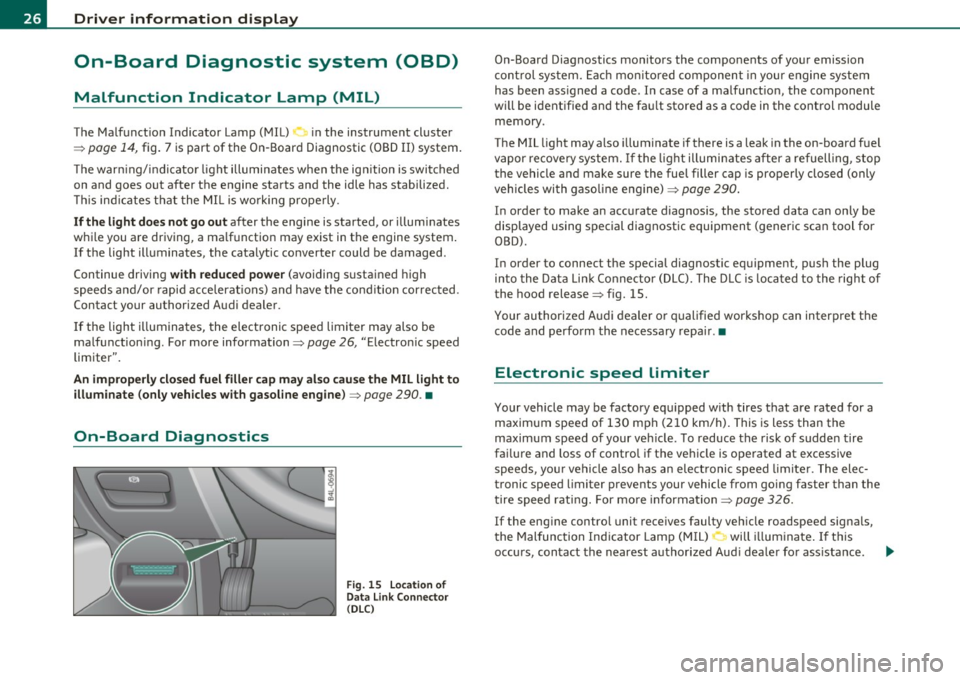
Driver information display
On-Board Diagnostic system (OBD)
Malfunction Indicator Lamp (MIL)
The Malfunction Indicator Lamp (MIL) • in the instrument cluster
~ page 14, fig. 7 is part of the On-Board Diagnostic (OBD II) system.
Th e warn ing/indicator light illuminates when the ignition is switched
on and goes out after the engine starts and the idle has stabilized.
Thi s ind icates that the MIL is working properly.
If
the light does not go out after the engine is started, or illuminates
while you are driving , a ma lf u nction may exist in the engine system.
If the light illuminates, the catalytic converter could be damaged.
Continue driving
with reduced power (avoiding sustained high
speeds and/or rapid accelerat ions) and have the condition corrected .
Contact your authorized Audi dealer .
If the light i lluminates, the electronic speed limiter may also be
malfunctioning. For more information~
page 26, "Electronic speed
limiter".
An improperly closed fuel filler cap may also cause the MIL light to
illuminate (only vehicles with gasoline engine)~
page 290. •
On-Board Diagnostics
Fig . 15 Location of
Data Link Connector
( DLC)
On-Board Diagnostics monitors the components of your emission
control system. Each monito red component in you r engine system
has been ass igned a code. I n case of a malfunct ion, the component
wi ll be ident ified and the fau lt stored as a code in the control module
memory .
The MIL light may also illuminate if there is a leak in the on-board fuel
vapor recove ry system. If the light illuminates after a refuelling, stop
the vehicle and make sure the fuel filler cap is properly closed (only
veh icles with gasoline engine)~
page 290.
I n order to make an accurate diagnosis, the stored data can only be
displayed using special diagnostic equipment (generic scan tool for
OBD).
In order to connect the special diagnostic equipment, push the plug
into the Data Link Connector (DLC). The DLC is lo cated to the right of
the hood release ~ fig. 15.
Your authorized Audi dealer or qualified workshop can interpret the
code and perform the necessary repair .•
Electronic speed limiter
Your vehicle may be factory equ ipped w ith tires that are rated for a
maximum speed of 130 mph (210 km/h). This is less than the
maximum speed of your veh icle. T o reduce the risk of sudden tire
fai lure and loss of contro l if the vehicle is operated at excessive
speeds, your vehicle a lso has an electronic speed limite r. The elec
tronic speed limiter prevents your vehicle from going faster than the
tire speed rating. For more information ~
page 326.
If the eng ine control unit receives faulty veh icle roadspeed signals,
the Malfunction Indicator Lamp (M IL) ..... will illuminate. If this
occurs, contact the nearest authorized Aud i dealer for ass istance . _.,
Page 164 of 390
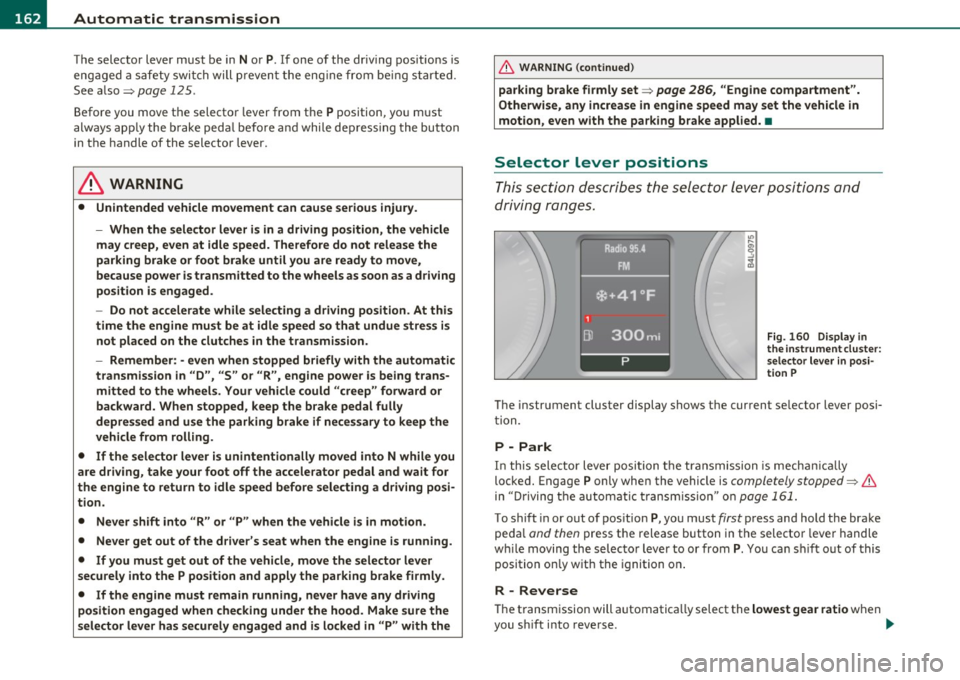
1111 ...... _A_ u_ t_o _m_ a_ t_ic _ t_ r_ a_ n_s _ m __ is_s_ , _·o _ n ____________________________________________ _
The selector lever must be in Nor P. If one of the driv ing positions is
eng aged a sa fety swi tch will p reven t the eng ine fr om being s tarted.
See also=>
page 125.
Before you move t he selecto r lever from t he P position, yo u m ust
a lw ay s a pply the brake ped al befo re a nd whi le de press ing the bu tton
in the handle of the selector lever.
& WARNING
• Unintended vehicle movement can cause serious injury.
- When the selector lever is in a driving position, the vehicle
may creep , even at idle speed. Therefore do not release the
parking brake or foot brake until you are ready to move,
because power is transmitted to the wheels as soon as a driving
position i s engaged .
- Do not accelerate while selecting a driv ing position . At this
time the engine must be at idle speed so that undue stre ss is
not placed on the clutches in the transmission .
- Remember: • even when stopped briefly with the automatic
transmission in "D", "S " or "R", engine power is being trans·
mitted to the wheels . Your vehicle could "creep " forward or
backward. When stopped, keep the brake pedal fully
depre ssed and use the parking brake if necessary to keep the
vehicle from roll ing .
• If the selector lever is unintentionally moved into N while you
are driving, take your foot off the accelerator pedal and wait for
the engine to return to idle speed before selecting a driving posi
tion .
• Never shift into "R" or "P " when the vehicle is in motion.
• Never get out of the d riv er 's seat when the engine is running.
• If you must get out of the vehicle, move the selector lever
securely into the P position and apply the parking brake firmly.
• If the engine must remain running, nev er have any driving
position engaged when checking under the hood. Make sure the
s e lector lever has securely engaged and is locked in "P " with the
& WARNING (co ntinued )
parking brake firmly set=> page 286, "Engine compartment".
Otherwise, any increa se in engine speed may set the vehicle in
motion, even with the parking brake applied. •
Selector Lever positions
Thi s sec tion describes the select or le ver p osit io ns and
driving ranges.
Fig. 160 Di spl ay in
th e in strument clu ster :
s elect or lever in posi·
t ion P
The instrument cluster display shows the current se lector lever posi
t ion.
P -Park
In th is selector lever posi tion t he transmission is mecha nically
loc ked. Engage P only when th e vehicle is
completely stopped=> &
in "Driving t he automatic transm ission" o n page 161.
To shift in or out of pos ition P, yo u must first press and hold the brake
pe dal
and then press t he release button in the selector leve r handle
w hil e moving the selec to r lever to or from P. Y ou ca n shi ft out of this
position on ly w it h the ignition o n.
R -Reverse
Th e transm ission will automatica lly select the lowest gear ratio when
you s hift into reverse . _,,
Page 220 of 390
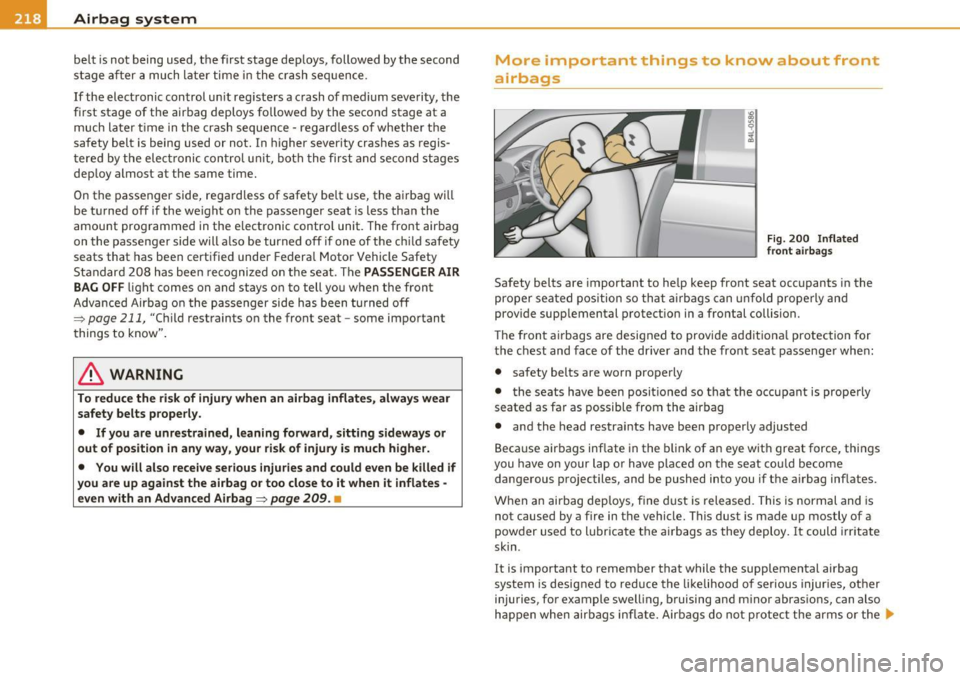
___ A_ i_ r_b _ a_ g=- s_, y"-- s_t _e _m ______________________________________________ _
belt is not being used, t he first stage dep loys, followed by the second
stage a fter a mu ch later time in the c rash seq uence .
If the electronic control un it reg isters a crash of medium severity, the
first stage of the airbag deploys fo llowed by the second stage at a
much la ter t ime in the crash sequence -regard less of whethe r th e
safety belt is being used or not. In higher sever ity crashes as regis
t ere d by t he elect ronic con tro l u ni t, both the first and second stages
dep loy almost at the same time.
On the passenger side, regardless of safety be lt use, the a irbag will
be turned off if the we ight on the passenger seat is less than the
amount prog rammed in the electronic contro l unit. The front airbag
on the passenge r side w ill a lso be turned off if one of the ch ild safety
seats that has been certified under Federa l Moto r Vehicle Safety
Standar d 208 has bee n recognized o n th e seat. The
PASSENGER AIR
BAG OFF light comes on and stays on to tell you w hen the front
Advanced Airbag o n the passenger side has been tu rned off
~ page 211, "Ch ild restraints on the front seat -some important
t hings to know" .
& WARNING
To reduce the risk of injury when an airbag inflate s, always wear
safety belts properly .
• If you are unrestrained, leaning forward, sitting sidewa ys or
out of position in any way , you r risk of inju ry is mu ch higher.
• You will also receive serious injuries and could even be killed if
you are up against the airbag or too close to it when it inflates· even with an Advanced Airbag~
page 209. •
More important things to know about front
airbags
Fig. 2 00 Inflate d
front a irb ags
Safety belts are important to he lp keep front seat occupants in the
pro per seated pos ition so that a irbags can unfold prope rly and
prov ide supp lemental protect ion in a frontal collision.
Th e front airbags are designed to provide add itio na l protec tion for
the c hest and face of the driver and the front sea t passenge r when:
• safety belts are worn properly
• the seats have been posit ioned so that the occupant is prope rly
seated as far as possible from the airbag
• and the head restraints have been properly adjusted
Because air bags inflate in the b link of a n eye w it h great force, things
you have on your lap o r have place d on the seat cou ld become
dangerous projectiles, and be pushed into you if the a irbag inf lates.
When a n airbag dep loys, fine dust is released. This is normal and is
not caused by a fire in the vehicle. This dust is made up mostly of a
powder used to l ubricate the ai rbags as they deploy.
It could irritate
skin .
It is important to remember that while the supp lemental airbag
system is desig ned to reduce the li ke lihood of serious injur ies, other
injuries, for example swelling, b ruising and m inor abras ions, can also
happen when airbags infl ate. Airbags do not p rotect the arms or the ..,_
Page 298 of 390
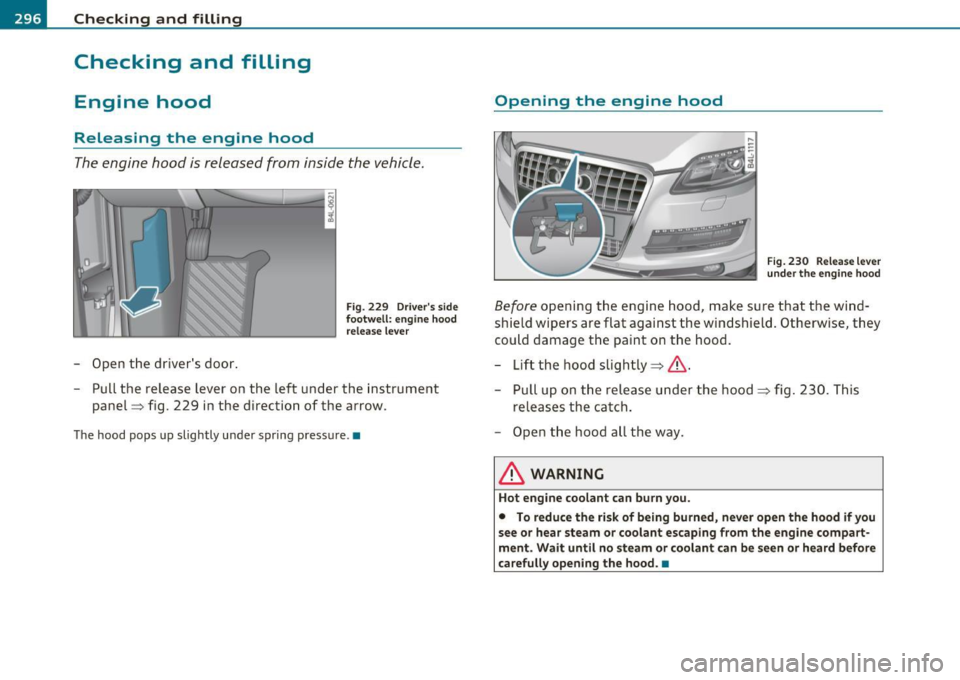
___ C_h_ e_c _k _i_n -=g :a,__ a_n_ d_ f_ i_ l _li _n _,g;._ __________________________________________ _
Checking and filling
Engine hood
Releasing the engine hood
The engine hood is released from inside the vehicle.
-Open the driver's door.
Fig. 229 Driver's side
footwell: engine hood
release lever
-Pull the release lever on the left under the instrument
panel => fig . 229 in the direction of the arrow .
The hood pops up slightly under spring pressure .•
Opening the engine hood
Fig. 230 Release lever
under the engine hood
Before opening the engine hood, make sure that the wind
shield wipers are flat against the windshield. Otherwise, they
could damage the paint on the hood.
- Lift the hood slightly =>& .
- Pull up on the release under the hood => fig. 230. This
releases the catch.
- Open the hood all the way.
& WARNING
Hot engine coolant can burn you.
• To reduce the risk of being burned, never open the hood if you
see or hear steam or coolant escaping from the engine compart
ment. Wait until no steam or coolant can be seen or heard before
carefully opening the hood. •
Page 378 of 390
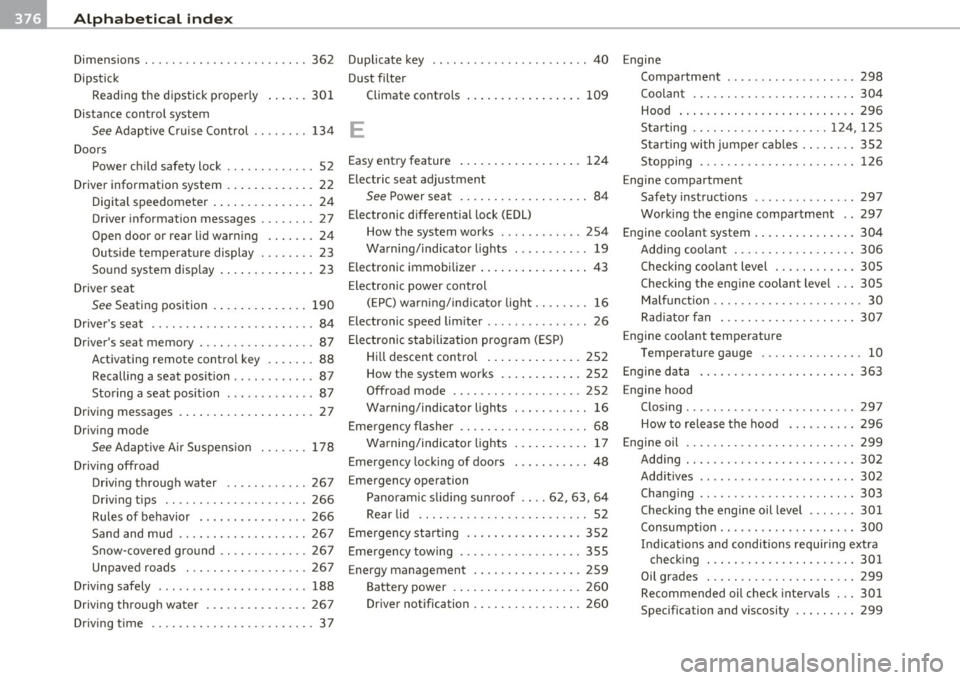
-Alphabetical inde x _ ___,_ ______ .::..:....=.:..:..__ __________________________ _
Dimensions ... ............ ....... .. 362
Dipstick
Reading the dipstick properly ......
301
Distance control system
See Adaptive Cruise Control ...... .. 134
Doors
Power child safety lock .............
52
Driver information system ......... .... 22
Digital speedometer ............... 24
Driver information messages ........ 27
Open door or rear lid warning ....... 24
Outside tempera ture display ..... ... 23
Sound system display .. .. ..... ..... 23
Drive r seat
See Seating position .............. 190
D. , river s seat . . . . . . . . . . . . . . . . . . . . . . . . 84
Driver's seat memory .............. ... 87
Activating remote control key .... ...
88
Recalling a seat position ............ 87
Storing a seat position ... .... .. .... 87
Driving messages .................... 27
Driving mode
See Adaptive Air Suspens ion . .... .. 178
Driving offroad
Driving through water .... .. ... ...
267
Dr iving tips .. ............ .... ... 266
Rules of behavior ........ .... .... 266
Sand and mud ................. .. 267
Snow -covered g round .. .. .... ..... 267
Unpaved roads . .. .. .. .. .... ..... 267
Driving safely . .. ..... ... ........... 188
Driving through water ... .. .. .. .... .. 267
D. . t· riving 1me .... .... ...... .......... 37
Duplicate key .. .. .. ..... ..... ... .. .. 40
Dust filter
Climate controls .................
109
E
Easy entry feature 124
Electric seat adjustment
See Power seat . . . . . . . . . . . . . . . . . . . 84
Electronic differential lock (EDL)
How the system works . ......... ..
254
Warning/indicator l ights ... ... ... .. 19
Electronic immobilizer ................ 43
Electronic power control
(EPC) warn ing/indicato r light ...... ..
16
Electronic speed limiter ... ..... ..... .. 26
Electronic stabilization program (ESP)
Hill descent control ........ ... .. . 252
How the system works .......... .. 252
Offroad mode ............ .. ..... 252
Warning/indicator l ights . .. .. .. .. .. 16
Emergency flasher . . . . . . . . . . . . . . . . . . . 68
Wa rning/indicator l ights ... .. .... .. 17
Emergency locking of doors ... .. .. .. .. 48
Emergency operation
Panoramic sliding sunroof .. ..
62, 63, 64
Rear lid ....... .. .... .. .. .. .... .. 52
Emergency start ing ........... ... .. . 352
Emergency towing .... ..... .... .. .. . 355
Energy management ........... .... . 259
Battery power .. .. .. .. .. .... ..... 260
Driver notification ............... . 260
Engine
Compartment ............... .. ..
298
Coolant ................. ... ... . 304
Hood . .. .. ..... .......... .. .. .. 296
Starting .. .... .. .. .. .. .. .... 124, 125
Starting with jumper cables .. .... .. 352
Stopping ........... ...... .... .. 126
Engine compartment
Safety instructions ...............
297
Working the engine compartment .. 297
Engine coolant system ............... 304
Adding coolant ............ .. .. .. 306
Checking coolant level ............ 305
Checking the engine coolant level . .. 305
Malfunction .. .. .. .. .... ... ..... .. 30
Radiator fan . .. .. ............... 307
Engine coolant temperature
Temperature gauge .. .... .. .. .. .. . 10
Engine data ................. .. .. .. 363
Engine hood
Closing ........ ... ... ... .. .. ....
297
How to release the hood .......... 296
Engine oil ............. ...... .... .. 299
Adding ............. .. .... .... .. 302
Additives .. ............ .... ... .. 302
Changing .. ..... ...... ... ... .. .. 303
Checking the engine oil level .... . .. 301
Consumption .. .. .... .. ...... .. .. 300
Indicat ions and conditions requiring extra
checking . .. .. .. .. .............
301
Oil grades . .. .. .... ............. 299
Recommended oil check intervals ... 301
Specifica tion and viscosity ..... .. .. 299
Page 380 of 390
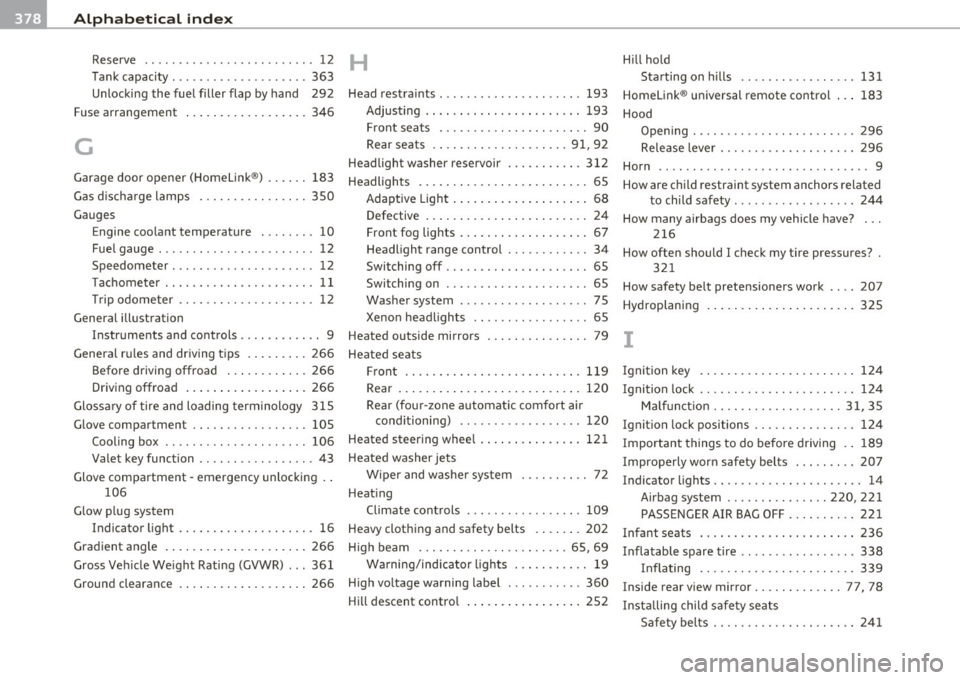
__ _:._A..:. l:.! p:.. h ::....:..:: a:.:b:.. e=-= t.:..:ic :.:a:.. l:.....:..: in~ d:...:e :..: x.:...._ ___________________________________________ _
Reserve ..... .... ........ .... ... . 12
Tank capacity . .. .. .. ...... ... .. .. 363
Unlocking the fuel filler flap by hand 292
Fuse arrangement ... ............... 346
G
Garage door opener (Homelink®) ...... 183
Gas d ischarge lamps ........ .. .... .. 350
Gauges Engine coolant temperature . ... .... 10
Fuel gauge . .... .. .... .. .. .. .. .... 12
Speedometer ... .. .. ........ .. . ... 12
T achometer ...................... 11
Tr ip odometer ............. .... .. . 12
General illustration Instruments and controls ............ 9
General rules and driving tips ......... 266
Before driving offroad ........ .... 266
Driving offroad .................. 266
Glossa ry of tire and loading terminology 315
Glove compartment ........ ......... 105
Cooling box ..... ........ .... .. .. 106
Valet key function ......... ... .. .. . 43
Glove compartment -emergency unlocking ..
106
Glow plug system
Indicator light ............. .... .. . 16
Gradient angle .................. ... 266
Gross Vehicle We ight Rating (GVWR) ... 361
Ground clearance .. .. ............ ... 266
H
Head restraints ............... .... .. 193
Adjusting .. .. .... .. .... .. .. .. ... 193
Front seats . . . . . . . . . . . . . . . . . . . . . . 90
Rear seats .. .. ........... ..... 91, 92
Headlight washer reservoir ........... 312
Headlights ............ ... .. .. ... ... 65
Adaptive Light ............. .... .. . 68
Defective . . . . . . . . . . . . . . . . . . . . . . . . 24
Front fog lights ............ ... .. .. 67
Headlight range control . ........... 34
Switching
off ......... .. .. .. .. .. .. 65
Switching on ......... .... .. ...... 65
Washer system . ..... ... . ... .. .. .. 75
Xenon headlights .... ............. 65
Heated outside mirrors
79
Heated seats Front ................... .. .... . 119
Rear ............... ..... .. .. .. . 120
Rear (four-zone automatic comfort air
conditioning) ..... ...... .. .. .. . 120
Heated steering wheel ... ..... ....... 121
Heated washer jets
Wiper and washer system .... .. .. .. 72
Heating Climate controls ............... .. 109
Heavy clothing and safety belts ....... 202
H igh beam ......... .... .... .. .. . 65 , 69
Warning/indicator lights ..... .. .. .. 19
High voltage warning label .... .... ... 360
Hi ll descent control ..... ............ 252 Hill hold
Starting on hills 131
Homelink ® universal remote control ... 183
Hood Opening ............ .... .... .. .. 296
Release lever ... .. .. ..... .. .. .. .. 296
Horn .................. .... ... ... ... 9
How are child restraint system anchors related to child safety .... ....... ... .. .. 244
How many airbags does my vehicle have? ...
216
How often should I check my tire pressures? . 321
How safety belt pretensioners work .... 207
Hydroplaning ......... ............. 325
I
Ignition key ................ ..... .. 124
Ignition lock .. .. ............. .. .. .. 124
Ma lfunct ion .... .. .. .... ....... 31, 35
Ignition lock positions ... .. .. .. .... .. 124
Important things to do before driving .. 189
Improperly worn safety belts ... .. .. .. 207
Indicator lights . . . . . . . . . . . . . . . . . . . . . . 14
Airbag system ....... .. .. .. .. 220,221
PASSENGER AIR BAG OFF .... .... .. 221
Infant seats ................ ... .. .. 236
Inflatable spare tire .. .. .. .. .. .... ... 338
Inflating ........... .. .... .... .. 339
Inside rear view mirror .. ........... 77, 78
Installing child safety seats Safety belts ............... .. .. .. 241
Page 383 of 390
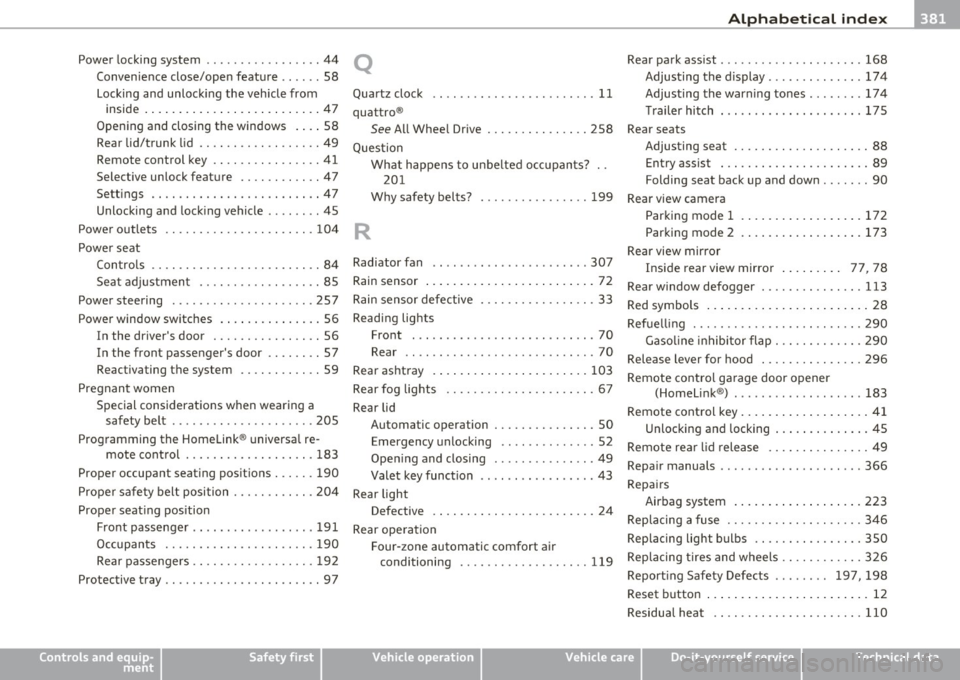
Alphabetical index fflll ___________________________________ ____._ _______ _
Power locking system .. .. .... .... ... .. 44
Convenience close/open feature .. .... 58
Locking and unloc king the veh icle from
inside ..... .. .. ... .. .. .. .... .. ..
47
Opening and closing the windows . .. . 58
Rear lid/trunk lid .... .. .. .. .. .. .. .. 49
Remote control key .. ...... .. .... .. 41
Selective unlock feature .. ...... .. ..
47
Sett ings .. .. ... .... ..... .. .. . .... 47
Unlocking a nd lock ing vehicle .. .. .. .. 45
Power outlets ............. .. .. .. .. . 104
Power seat Con tro ls .. .. ........... ...... .. ..
84
Sea t adju stmen t .... ...... .. .. .. .. 85
Power steering ..... ... . .... ... .. .. . 257
Power window switches . ..... .. .. ..... 56
In the driver's door ........... .... . 56
In the front passenger 's door .... .. .. 57
Reactivating the system .. ...... .. .. 59
Pregnan t women
Special considerations when wearing a safety be lt ..... ... .. ... ... .. .. . 205
Programming the Homelink ® universa l re-
mote cont rol .......... .. .... .. . 183
Proper occupant seating pos it ions . .... . 190
Proper sa fe ty belt posi tion ......... .. . 2 04
Prope r seat ing position
Front passenge r .. .. .... ......... . 191
Oc cupants ......... .. .. .. ... ... . 190
Rear passe ngers .. ...... ....... ... 19 2
Protective tray ............... .. .. .. .. 97
Controls and equip
ment Safety first
Q
Quartz clock
...... .................. 11
quattro ®
See All Whee l Drive ....... .. .... .. 258
Ques tion
Wh at happe ns to u nbe lte d occ upan ts? . .
201
Why safety belts? ................ 199
R
Rad iator fan .. .... .... ......... .... 307
Rain sensor ... .. .. .... ... . ... .... .. . 72
Rain sensor defe ctive ........ ...... .. . 33
Readi ng lights
Front ........................... 70
Rear .. .. .. .. .. .... ... ... .... .. .. 70
Rear ashtray . ... .... .. .. .. .. .. .. ... 103
Rear fog lig hts .. ....... .... .. .. .. .. . 67
Rear lid Automatic operation ............ .. . 50
Emergency unlocking .. .. .. ... ... .. 52
Ope ning and closing .............. . 49
Valet key funct ion ...... ... ........ 43
Rear light Defective .. .. .. ... ... ............ 24
Rear ope ra tion
Four -zone automatic comfort air
conditioning ...... ... ... .... .. . 119 Rear park assist ..
... ..... ... ... .. .. . 168
Adjusting the display ....... .. .. ... 17 4
Adjusting the warning tones ........ 17
4
Trailer hitch . .. .. .. .. .. ... ..... .. 175
Rear seats Adjusting seat ...... ...... .. . ... .. 88
Entry assist . .. .. .. ............... 89
Folding seat back up and down .. .. ... 90
Rear view camera Parking mode 1 . ... ...... ... . ... . 172
Parking mode 2 . ... ...... .. .. ... . 173
Re ar view mir ror
I ns ide rear view m irro r . . . . . . . . . 7 7, 78
Rear window defogger ............. .. 113
Red symbols ... .. .. .. ...... .. .. ... .. 28
Ref ue lli ng ... .... ........... .... .. . 290
Gaso line inh ibitor fl ap ............ . 290
Release lever for hood . ....... .. .. .. . 296
Remote cont rol ga rage door o pener
(Homeli nk® ) .... ....... ... .. ... 183
Remote control key ... ... .... ... . .. ... 41
Unloc king and locking ... .. .. .. .. .. .
45
Remote rear lid release ............... 49
Repa ir manuals ..... .... ... .. .. .. ... 366
Repai rs
Airbag system ..... .. . .... .... .. . 223
Rep lacing a fuse ....... .. .. .. .. .. .. . 346
Replacing light bulbs .. .. .. .......... 350
Rep lacing tires and w heels .. .......... 3 26
Report ing Safety Defects . . . . . . . . 19 7, 198
Reset button ...... . .. .. .. .. ... .... .. 12
Residua l heat .. .. .. .. .............. 110
Vehicle operation Vehicle care Do-it-yourself service Technical data